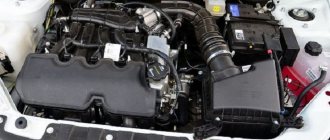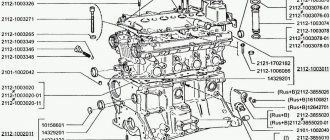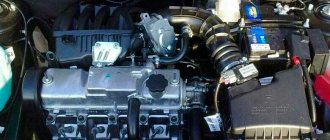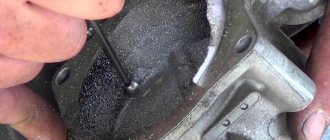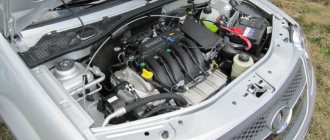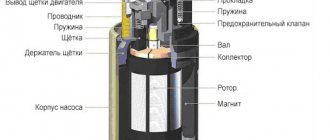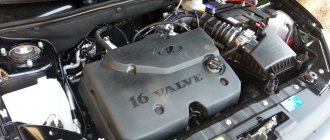Description
The VAZ-11183 engine was designed and put into production in 2004. Many design elements are taken from the VAZ-21114 engine. VAZ-11183 was produced until 2021. In 2011 it underwent a slight modernization, as a result of which it received an electronic drive for controlling the throttle valve (gas pedal).
The VAZ-11183 is a 1.6-liter gasoline inline four-cylinder engine with a power of 80 hp. s and torque 120 Nm.
Installed on Lada cars:
- 2112 (2004-2008);
- 2113 Samara (2004-2014);
- Grant (2011-2018);
- Kalina (2004-2013).
In addition to Lada, it can be seen under the hood of On-Do 1 (Datsun).
The opinion of auto experts about the engine is clear - the engine is simple in design and design compared to many other 8-valve AvtoVAZ engines.
The cylinder block is made of high-strength cast iron. The height is increased by 2.3 mm (compared to the VAZ-2110). Not sleeved.
The cylinder head is aluminum, with one camshaft and 8 valves (SOHC). To increase the compression ratio, the volume of the combustion chambers has been increased. There are no hydraulic compensators, so the thermal clearance of the valves has to be adjusted manually.
The crankshaft is steel, forged. It has a crank radius increased by 2.3 mm, which provides a piston stroke of 75.6 mm.
Timing belt drive. The main advantage is that the valves do not bend when they meet the pistons when the belt breaks. The engine simply stalls at this moment.
The attachments have their own drive belts.
Alternator belt drive
Power supply system – injector, distributed fuel injection. Practice has shown the possibility of using AI-92 gasoline. Justification - the compression ratio does not exceed 10 units (above 10 - only AI-95 or AI-98).
The advantage of the engine is the reserved safety margin, i.e. there is the possibility of tuning without reducing the mileage resource.
Specifications
| Manufacturer | Concern "AvtoVAZ" | |
| Engine code | VAZ-11183 | VAZ-11183-50 |
| Start year of release | 2004 | 2011 |
| Volume, cm³ | 1596 | 1596 |
| Power, l. With | 80 | 82 |
| Torque, Nm | 120 | 132 |
| Compression ratio | 9.6 | 9.8 |
| Cylinder block | cast iron | cast iron |
| Number of cylinders | 4 | 4 |
| Fuel injection order | 1-3-4-2 | 1-3-4-2 |
| cylinder head | aluminum | aluminum |
| Cylinder diameter, mm | 82 | 82 |
| Piston stroke, mm | 75.6 | 75.6 |
| Number of valves per cylinder | 2 | 2 |
| Timing drive | belt | belt |
| Turbocharging | No | No |
| Hydraulic compensators | No | No |
| Valve timing regulator | No | No |
| Lubrication system capacity, l | 3.5 | 3.5 |
| Oil used | 5W-30 (40), 10W-40, 15W-40 | 5W-30 (40), 10W-40, 15W-40 |
| Fuel supply system | injector | injector |
| Fuel | gasoline AI-92 | gasoline AI-95 |
| Environmental standards | Euro 2-3 | Euro 4 |
| Resource, thousand km | 150 | 150 |
| Location | transverse | transverse |
| Weight, kg | 112 | 112 |
| Tuning (potential), l. With | 180* | 180* |
*tuning up to 120 hp is possible without loss of service life. With.
Engine VAZ-11183-50
This engine is a modification of the VAZ-11183. There are no fundamental design differences, but as a result of modifications:
- Power increased to 82 hp. With.
- Torque increased by 12 Nm.
- The environmental standard has increased to Euro
The main difference is that the unit is equipped with an electronic throttle control mechanism (type of action - “E-Gas”). The innovation improved engine controllability, but at the same time created a problem with the TPS sensor.
Engine builders managed to eliminate a number of shortcomings that were observed on its predecessor. For example, constant contamination of the throttle valve is a thing of the past.
Throttle Position Sensor (TPS)
As a result of modernization, the level of torque of the internal combustion engine and its elasticity have increased.
Car enthusiasts note that in general the engine has become more reliable and less capricious. At the same time, engine efficiency has decreased.
Engine malfunctions VAZ 11183
The VAZ-11183 power plant is a logical continuation of the VAZ-21114 engine and even the early VAZ-21083 unit. Since the design part of some mechanisms remained unchanged, the shortcomings of these units migrated to the followers. Nevertheless, the motor is popular, durable, and reliable. With proper operation, overhaul of the 11183 engine will not be required until the product “runs” 200,000-250,000 km.
The disadvantages of the model include the need to adjust the valves, wear of the cooling circuit, contamination of the oil filter element, and leakage of lubricant through the valve cover seal. In addition, the fuel pump wears out quickly, the exhaust pipe clamp breaks, and the injection periodically becomes clogged.
The list of frequently encountered problems includes:
- The engine does not hold speed and stalls.
The problem is typical when operating at idle speed; if a problem is detected, contact the service center. The reason lies in the idle speed regulator, a device that determines the position of the throttle valve, or in the vacuum mechanism. It would be a good idea to check the mass air flow sensor.
Replacing the thermostat:
- The operation of the motor is not smooth and is accompanied by jerking.
The first step is to measure the compression in the chambers. If the value in the chamber differs sharply from the value of the other cylinders, a burnt valve is obvious. If the difference is not great, adjust the valves of the product and check the condition of the seal. If the compression reading is normal, the cause is sought in the ignition circuit.
- The motor does not heat up to operating temperature.
The permissible operating temperature of the power plant ranges from 91-103°C. The reason why the engine is unable to reach the set mode lies in a faulty thermostat. To fix the problem, the product is replaced with a new one.
- The operation of the motor is accompanied by knocking and noise.
This state of affairs is not uncommon; symptoms are observed in all kinds of operating modes. The cause of the problem lies in the valves that are being adjusted. In the worst case, a dull metallic knock that intensifies when you press the gas pedal indicates a breakdown of the crankshaft main bearings. Breakage of the connecting rod bearings is also possible. Solving the problem is impossible without the intervention of experienced personnel, since we are talking about engine overhaul. A dull knock, among other things, indicates wear of the displacers in the chamber.
Reliability, weaknesses, maintainability
Reliability
According to the conclusion of servicemen and car owners, the VAZ-11183 is more reliable in comparison with the concern’s previously produced engines. The increased quality of components and mechanisms used in the engine is especially noticeable.
The manufacturer has determined the average mileage resource. In reality, it is more than twice as much as stated. This fact is clearly confirmed by the increased reliability of the unit.
In addition, the engine is unpretentious during operation. The lubrication system especially benefits in this regard. The oil quality requirements are somewhat underestimated due to the lack of hydraulic compensators. The stable operation of the engine on low-octane gasoline also pleases most car owners. In other words, the efficiency of the internal combustion engine has been increased without sacrificing reliability.
The reliability of the timing system is beyond praise. A broken drive belt does not cause the valves to bend, which saves the car owner from expensive repairs.
On various forums you can find the following reviews: “... the engine is class, the traction is what you need, at low speeds 3 uphill, and even with a load of 4 people. 80 kg each. I only fill with 92, because... the engine is structurally very simple, it doesn’t need much to work well.” Another one - “... the 1.6 eight-valve engine is, by today’s standards, a stone age. But let's take a closer look at how it behaves on the road. When fully loaded, the power is quite enough, I drove the swallow 150 and there is still some reserve left.”
Thus, we can conclude that the VAZ-11183 is a completely reliable and economical engine.
Weak spots
Every engine has weak points. The unit in question did not escape them either.
Most often, car owners are alarmed by knocking noises in the engine. Moreover, both warm and cold. It is appropriate to note here that the engine itself is quite loud in operation (a design feature of the engine). But knocking can also be caused by unregulated valves. In any case, to find out the reasons for the loud operation, you need to contact a car service.
Engine overheating. The problem is typical for all VAZ engines. Usually solved by replacing the thermostat.
Electrics. It is also a weak link. Especially the different sensors. For example, DMRV. The result of its failure is engine failure (stalls while driving). Computer diagnostics of the internal combustion engine will help identify the resulting malfunction. Sometimes the ECU starts to malfunction. Also, you can’t do without computer diagnostics here.
Troubling of the internal combustion engine at idle speed can be caused by unadjusted valve clearances or burnt-out valves. The cause may be spark plugs. The true cause of the tripping can be easily identified at a specialized service station.
Oil leakage is a fairly common occurrence. The problem lies in poor-quality seals of mating parts and engine components. A simple tightening or replacement of the oil seal (gasket) allows you to forget about oil leaks for a long time.
In any case, the engine must be constantly monitored and any detected faults must be corrected in a timely manner.
Weaknesses of the VAZ 11183 engine
The most frequently recurring weaknesses are the Generator. Suddenly, after purchasing a new car, you began to hear an incomprehensible hum under the hood? There may be many reasons, but cynical statistics will indicate to you that most likely you are faced with the destruction of the generator bearing. The engine design does not provide a mechanism for adjusting the tension of the generator belt, and the driver can check the tension only by turning the belt 90 degrees. This problem can be resolved. It is possible to install a modified mechanism for tensioning and adjusting the alternator belt, which is available for free sale in auto supply stores.
Throttle valve. During the modernizations, the designers were able to solve the problem of rapid contamination of the throttle on previous AvtoVAZ engines and install an electronic throttle valve drive, but it still happens that the operation of the unit on the Granta engine is disappointing due to floating idle speed and spontaneous engine stops. The recipe is still the same - flushing the throttle assembly with carburetor cleaning fluid.
Mass air flow sensor. If you notice a loss of power, an increase in fuel consumption and a check light on the dashboard. These reasons indicate the need to check the mass air flow sensor, for which you need to arm yourself with a multimeter and a 10mm wrench. The driver should find the yellow wire output in the sensor connector (it is closer to the windshield) and the green output (third from the left on the same side ). These sensor outputs are exactly what we need. In cars of different years in the electrical circuits, the colors of these wires may differ, but the locations of the terminals are the same. To monitor performance, the voltage is measured between the indicated terminals with the ground turned on and the motor not running. The size of the tester probes is capable of passing through the rubber seals of the connectors, along the specified wires, without disturbing their insulation. We turn on the mass, connect the multimeter and observe. The voltage on a working sensor will be 0.996…1.01 Volts. If the voltage is up to 1 V, everything is in order - we look further for reasons, but if it is higher - we simply replace it with a new one and rejoice at the improvement in the throttle response and efficiency of the internal combustion engine.
Ignition coils are not highly reliable. Malfunctions with them are determined by a lit check on the device, a sharp decrease in power and weak acceleration. Fans of electrical circuits can test the coil with a tester for the presence of interturn short circuits. The solution is still the same - a banal replacement of the part.
Cooling system thermostat. The bypass valve gets stuck in the cold and the engine does not warm up or takes a very long time to warm up. This is due to the low quality of manufacturing of domestic parts. In case of similar problems, I recommend that owners find a compatible analogue of higher quality.
Electronic control unit. It is located under the front panel and, as a result, is often filled with coolant, since the hoses and pipes of the engine cooling system are in close proximity. An option to get rid of problems in the future is to move it under the glove compartment.
Valve mechanism. The valves on this engine can simply burn out. It is not yet clear whether the reason lies in the quality of the factory adjustment of thermal clearances or whether the fuel coupled with overheating is to blame. But one way or another, the scanner detects error P0363 and the owner urgently needs to go to the service center. Otherwise, problems may begin with the connecting rod and piston group.
Connecting rod and piston group. Those who did not have time to avoid burning out valves or sinking compression and oil rings will encounter problems such as high oil consumption and black smoky exhaust in all modes of internal combustion engine operation. There is only one way out - qualified repairs with replacement of rings. The use of low-quality oil and a clogged oil filter can lead to scuffing on the piston body and to the same crankshaft problems mentioned earlier.
Starter. If you hear the sound of the starter working, but the engine refuses to start, do not rush to blame the battery. The issue may be loose starter mounts or damaged rotor gear teeth that mesh with the flywheel; the solenoid relay may also have burned out. If the teeth are broken off or heavily worn, we will hear a grinding noise when the starter operates; if the relay fails, there will only be the sound of an idling electric motor. It’s not that difficult to fix: tighten the fastenings, replace the gear, replace the relay.
